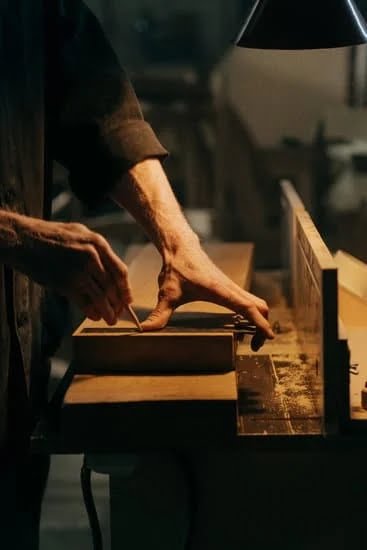Stripping woodwork of paint is an essential part of maintaining and refurbishing the natural beauty of wooden surfaces. Whether restoring an old piece of furniture or renovating a room, knowing how to strip woodwork of paint is a valuable skill for DIY enthusiasts and professionals alike. In this article, we will explore the various methods and techniques for effectively removing paint from woodwork, as well as the tools and materials needed for the job.
Before diving into the step-by-step guides for using chemical paint stripper, a heat gun, or sandpaper for paint removal, it is important to understand why stripping woodwork of paint is crucial. Over time, layers of paint can build up and obscure the natural grain and texture of the wood. By removing the old paint, you can expose the beautiful wood underneath and create a fresh canvas for refinishing or repainting.
Additionally, stripping woodwork of paint allows for better adhesion of new finishes or paints, ensuring a more durable and long-lasting result. Whether you are looking to restore antique furniture to its former glory or update your home’s interior with a new color scheme, properly stripped woodwork provides a solid foundation for your desired aesthetic.
In the following sections, we will delve into the specific tools and techniques needed for this important task, as well as safety measures to keep in mind while working with potentially hazardous materials.
Tools and Materials Needed for the Job
Chemical Paint Stripper
When it comes to stripping woodwork of paint, using a chemical paint stripper is an effective method. This requires having the right tools and materials on hand for the job. Some essential items include chemical paint stripper, disposable gloves, safety goggles, a paint scraper, a wire brush, steel wool, and plenty of ventilation in the workspace. It’s important to make sure that the chemical paint stripper is suitable for use on wood surfaces.
Heat Gun
Another option for removing paint from woodwork is using a heat gun. To do this, you’ll need a heat gun with different temperature settings or at least 1,100 watts of power, as well as protective gear such as gloves and safety goggles. Additionally, have a putty knife or scraping tool ready to remove the softened paint. It’s crucial to ensure that there are no flammable materials nearby as the heat gun can reach high temperatures.
Sandpaper
For those who prefer a more traditional approach, sandpaper can also be used to strip woodwork of paint. Stock up on various grits of sandpaper so that you have options for both coarse and fine sanding. In addition to sandpaper, you might also want to invest in a sanding block or electric sander for larger areas. Make sure to wear a dust mask and eye protection when sanding to avoid inhaling particles.
It’s important to gather all the necessary tools and materials before starting the project so that you can work efficiently without interruptions. Each method requires specific items for safe and effective use in stripping woodwork of paint.
Preparing the Workspace and Ensuring Safety Measures
Before starting the process of stripping woodwork of paint, it is crucial to prepare the workspace and take necessary safety measures to avoid any accidents or injuries. The first step is to gather all the tools and materials needed for the job, such as chemical paint stripper, heat gun, sandpaper, gloves, safety goggles, and a well-ventilated area.
Once you have all the necessary tools and materials, it is important to prepare the workspace by removing any furniture or items that may get in the way. Cover the surrounding area with a drop cloth or plastic sheeting to protect floors and walls from any drips or spills. Additionally, ensure that the workspace is well-ventilated by opening windows or using fans to minimize exposure to fumes from the paint stripper.
When working with chemical paint stripper or a heat gun, it is essential to wear protective gear such as gloves and safety goggles to prevent direct contact with the chemicals and hot surfaces. Always follow the manufacturer’s instructions for proper use of these tools and materials to avoid any potential hazards.
| Tools Needed | Materials Needed |
|---|---|
| Chemical paint stripper | Gloves |
| Heat gun | Safety goggles |
| Sandpaper | |
| Drop cloth or plastic sheeting |
Step-by-Step Guide on Using Chemical Paint Stripper
Chemical paint strippers can be a highly effective way to remove stubborn paint from woodwork. Before beginning this process, it is important to gather the necessary tools and materials, including safety equipment such as gloves, goggles, and a respirator to protect against fumes. Additionally, make sure to work in a well-ventilated area and cover nearby surfaces to prevent any damage from the chemical stripper.
To start the process of using a chemical paint stripper, begin by applying an even coat of the stripper onto the woodwork using a brush or roller. It’s important to follow the manufacturer’s instructions for application and wait for the recommended amount of time for the chemical to work. This usually involves allowing the stripper to sit on the woodwork for a specific period before starting to remove the softened paint.
Once the paint has had time to soften, use a scraper or putty knife to gently remove the old paint. Be sure to work in small sections at a time and continue applying more stripper as needed. After removing all of the old paint, thoroughly clean and rinse the woodwork with water before allowing it to dry completely.
Finally, sand down any remaining rough spots or residue before finishing with a new coat of stain or varnish. Following these steps carefully will ensure that your woodwork is effectively stripped of paint while maintaining its integrity and beauty.
Step-by-Step Guide on Using a Heat Gun for Paint Removal
Using a heat gun for paint removal is a highly effective method for stripping woodwork of multiple layers of paint. This process works by heating the old paint until it softens and can be easily scraped off. It is important to note that using a heat gun requires caution and attention to safety measures, as the tool can reach high temperatures. Here’s a step-by-step guide on how to effectively use a heat gun for paint removal.
Prepare the Work Area
Before starting the process, clear the work area of any flammable materials and ensure good ventilation. It is also advisable to wear protective gear such as gloves, goggles, and a mask to protect yourself from potential fumes and debris.
Heat the Paint
Hold the heat gun approximately 2-4 inches away from the surface of the woodwork. Move the heat gun slowly back and forth over a small section of paint until it begins to bubble and soften. Avoid concentrating too much on one spot for too long, as this can scorch or damage the wood.
Scrape Off the Softened Paint
As the paint softens, use a putty knife or scraper to gently remove it from the woodwork. Work in small sections at a time, reapplying heat as needed to soften stubborn areas of paint.
Repeat this process until all layers of paint have been removed from the woodwork. Once finished, clean any leftover residue with mineral spirits or a mild solvent.
Using a heat gun for paint removal can be an efficient method for stripping woodwork of old layers of paint. However, it is important to exercise caution and follow safety protocols throughout the process. With proper preparation and technique, you can achieve beautifully stripped woodwork ready for refinishing or painting.
Step-by-Step Guide on Using Sandpaper for Paint Removal
When it comes to removing paint from woodwork, using sandpaper is a traditional yet effective method. This section will provide a detailed step-by-step guide on how to strip woodwork of paint using sandpaper.
First, gather the necessary tools and materials for the job. You will need coarse-grit sandpaper (around 60-80 grit), medium-grit sandpaper (around 100-150 grit), fine-grit sandpaper (around 180-220 grit), a sanding block or electric sander, safety goggles, a dust mask, and gloves.
Before starting the process, ensure that the workspace is well-ventilated and free from any potential fire hazards. It is important to take safety measures seriously when working with sandpaper and paint removal.
Begin by using the coarse-grit sandpaper to remove the bulk of the paint from the woodwork. Sand in the direction of the wood grain, applying even pressure. Once most of the paint has been removed, switch to the medium-grit sandpaper to smooth out any remaining rough spots. Finally, use the fine-grit sandpaper for a finished, polished look.
Continue with this process until all desired layers of paint have been removed and the natural wood is revealed. Be mindful of any intricate details in the woodwork or hard-to-reach areas. Use smaller pieces of sandpaper or a sanding block to access these areas effectively.
Using sandpaper for paint removal can be a time-consuming process but yields great results when done correctly. Remember to clean up any dust and debris after completing this method before moving on to cleaning and finishing the woodwork for a polished final look.
Tips for Handling Stubborn Paint or Hard-to-Reach Areas
When it comes to stripping woodwork of paint, there are often stubborn areas or hard-to-reach spots that require special attention. Here are some tips and techniques to effectively handle these challenging aspects of the job:
- Use a wire brush or old toothbrush: Sometimes, paint can be particularly stubborn in certain nooks and crannies. In these cases, using a wire brush or an old toothbrush can help to physically scrub away the paint without damaging the wood underneath.
- Utilize a detail sander: For intricate details or small, hard-to-reach areas, a detail sander can be incredibly useful. These small sanders are designed to access tight spaces and provide precision when removing stubborn paint.
- Try a different type of paint stripper: If you’ve been struggling with a certain area using chemical paint stripper, it may be worth trying a different type or brand of stripper. Some formulas are better suited to certain types of paint or wood, so experimenting with different options could yield better results.
- Consider professional assistance for extremely difficult areas: In some cases, especially with antique furniture or delicate woodwork, it may be best to seek professional help for handling stubborn paint. A professional will have the expertise and specialized tools to tackle even the most difficult areas without causing damage.
As you encounter stubborn paint or hard-to-reach areas during the process of stripping woodwork, keep these tips in mind to ensure thorough and effective removal without compromising the quality of your woodwork.
Cleaning and Finishing the Woodwork After Paint Removal
Once the paint has been successfully stripped from the woodwork, it is important to thoroughly clean and finish the surface to ensure a polished and pristine result. Cleaning the woodwork after paint removal is essential to remove any residue from the stripping process, while finishing will protect and enhance the natural beauty of the wood.
To clean the woodwork after paint removal, begin by wiping down the entire surface with a damp cloth to remove any leftover chemical stripper or dust from sanding. Use a mild detergent or cleaner specifically formulated for wood surfaces to ensure that all traces of the paint remover are gone. After cleaning, allow the woodwork to dry completely before proceeding with finishing.
When it comes to finishing the woodwork after paint removal, there are various options available such as applying a clear coat, stain, or varnish. Before starting, it’s important to consider the type of wood and desired end result.
For example, if you want to highlight the natural grain of the wood, using a clear coat may be sufficient. On the other hand, if you want to add color and depth, applying a stain followed by a protective varnish would be ideal.
After choosing and applying the appropriate finish, allow it to dry according to manufacturer’s instructions. Once dried, inspect the woodwork for any imperfections or areas that may need additional touch-ups. Finally, stand back and admire your beautifully stripped and finished woodwork – a true testament to your hard work and attention to detail.
Common Mistakes to Avoid and Troubleshooting Tips
When it comes to stripping woodwork of paint, there are some common mistakes that people often make which can lead to frustration and wasted time. Avoiding these mistakes and being prepared with troubleshooting tips can make the process much smoother and more successful.
Here are some common mistakes to avoid when stripping woodwork of paint:
- Using the wrong type of chemical paint stripper for the type of paint on the woodwork
- Not properly preparing the workspace or protecting surrounding areas from potential damage
- Rushing through the process and not allowing enough time for the paint stripper to work effectively
Troubleshooting Tips:
If you encounter stubborn paint or hard-to-reach areas during the paint stripping process, there are a few methods you can try to overcome these challenges:
- Use a small brush or toothbrush to apply paint stripper to intricate or detailed areas
- For stubborn, hard-to-remove paint, consider using a heat gun in combination with chemical paint stripper for more effective results
- If sandpaper alone is not removing all of the remaining paint, try using a wire brush attachment on a drill for added power
By being aware of these common mistakes to avoid and having troubleshooting tips at hand, you can ensure a successful woodwork paint stripping project. Remember, patience and attention to detail are key when tackling this task.
Conclusion
In conclusion, knowing how to strip woodwork of paint can be a valuable skill for preserving and restoring the natural beauty of wooden surfaces. Whether you are looking to update the look of your home or salvage a piece of antique furniture, the process of removing old paint can be rewarding and ultimately lead to stunning results.
By following the right techniques and using the appropriate tools, you can successfully strip woodwork of paint without causing damage to the underlying surface.
It is important to remember that before you begin any project involving paint removal, it is essential to gather all necessary tools and materials. Whether you opt for a chemical paint stripper, heat gun, or sandpaper method, each approach requires specific equipment for optimal results. Additionally, preparing the workspace and adhering to safety measures are crucial steps in ensuring a smooth and hazard-free process.
After successfully stripping the woodwork of paint, proper cleaning and finishing is imperative for long-term maintenance. This step not only enhances the natural appearance of the wood but also protects it from future damage. Whether through varnishing, staining, or sealing with wax or oil, there are various finishing options available that can cater to different preferences and needs. Ultimately, by maintaining stripped woodwork properly, you can enjoy its rejuvenated appearance for years to come.
Frequently Asked Questions
What Is the Best Way to Remove Paint From Woodwork?
The best way to remove paint from woodwork is to use a chemical paint stripper. This can effectively break down the layers of paint, allowing for easier removal. It’s important to follow the manufacturer’s instructions and wear protective gear when using chemical strippers. Another method is sanding, which can also be effective but requires more time and effort.
What Is the Easiest Way to Strip Wood?
The easiest way to strip wood is by using a heat gun. This method involves applying heat to the surface of the wood, which causes the old finish to bubble up, making it easier to scrape off. Heat guns are readily available at hardware stores and can make the process of stripping wood less labor-intensive compared to other methods.
Is It Worth Stripping Paint From Wood?
Whether or not it’s worth stripping paint from wood depends on individual preferences and the condition of the woodwork. Stripping paint can reveal the natural beauty of the wood, allowing for refinishing and restoration.
However, it can be time-consuming and messy, so some people may opt to simply cover existing paint with a new coat instead. Ultimately, the decision should be based on factors such as personal taste, budget, and the overall condition of the wood.

Hi everyone! I’m a woodworker and blogger, and this is my woodworking blog. In my blog, I share tips and tricks for woodworkers of all skill levels, as well as project ideas that you can try yourself.





